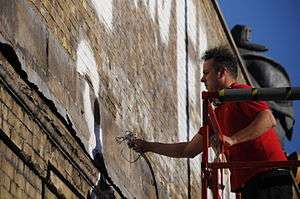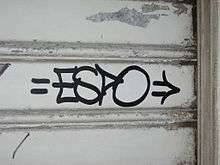Stephen Powers (artist)


Stephen J. Powers (born May 25, 1968) is a New York City artist who at one time wrote graffiti in Philadelphia and New York under the name ESPO ("Exterior Surface Painting Outreach").[1]
Background

.jpg)


Powers is from Philadelphia's Overbrook neighborhood; he graduated from Robert E. Lamberton High School in 1987 and took classes at The Art Institute of Philadelphia and the University of the Arts.[2] In 1994, he moved to New York with fellow writer and designer Ari Forman, in order to expand the reach of On the Go magazine.[3]
Graffiti
He was most well known during the late 1990s for his conceptual pieces as well as his role as the editor and publisher of On the Go Magazine.[4] ESPO's work often blurred the lines between illegal and legal. For example, pieces like "Greetings from ESPOLand" utilized the style of the Asbury Park Billboards and appeared to be a legitimate billboard. On January 4, 1997 ESPO began his most ambitious non-commissioned art.[1] He painted on storefront grates in Fort Greene, Bedford-Stuyvesant, TriBeCa and the South Bronx, covering the entire grate with white or silver paint and then using black to make each grate into a letter in his name.[3] Powers painted in daylight, wearing street clothes; he told the New York Times in 1999 that when passersby asked what he was doing he would tell them, "I'm with Exterior Surface Painting Outreach, and I'm cleaning up this gate"; the official-sounding name, and clever acronym was enough to ward most people off.[3] Powers targeted shops that appeared to be out of business and grates that were already heavily vandalized. He described his graffiti as a public service,[3] and by 1999 said that he had painted around 70 grates.[3]
Arrest
In December 1999 Powers was arrested at his home for graffiti vandalism after he had participated in a protest conceived by multimedia artist Joey Skaggs. The protest was against Mayor Rudolph Giuliani's attempt to shut down the controversial art show "Sensation" at the Brooklyn Museum. Powers contends that the arrest was politically motivated.[5] A New York Times editorial criticized the Giuliani administration for its secrecy in the case, but dismissed Powers as "a noodge and self-promoter, one of those deliberately annoying characters whom most of us could do without."[6] The Village Voice sympathized with ESPO’s plight saying “it's truly scary to think that if you invite people to throw artificial dung at a portrait of the mayor—especially one that resembles the infamous Madonna, packing them in at the Brooklyn Museum—the police will raid your apartment. And if they spot a set of brass knuckles hanging on the kitchen wall, they will bust you for possessing a weapon.” However, the author was also critical of Power’s graffiti status, describing him as an egotistical, careerist "celebrity offender"; the author writes, "in the graffiti world...many consider Powers a media-fed simulation of the Real Thing."[7] Powers was charged with six counts of criminal mischief and he eventually accepted a plea bargain and performed five days of community service.[8]
Artist
In 2000 Powers gave up graffiti to become a full-time studio artist. His work has been shown at the prestigious Venice and Liverpool Biennials, as well as numerous shows at New York City's Deitch Gallery. In 2003, Powers designed the artwork for Tommy Guerrero's third studio album Soul Food Taqueria. In 2005 he curated "The Dreamland Artists Club", a project in which professional artists helped Coney Island merchants by repainting their signs. Powers first solo museum exhibition was in the fall of 2007, at the Pennsylvania Academy of the Fine Arts which showed much of the work he had been working on at his Coney Island sign shop.[8] The show attracted attention in New York and Philly and in the beginning of December ESPO graced the cover of the art magazine Juxtapoz, where they wrote that, “In 10 years time, Stephen 'ESPO' Powers’ name will reside next to Crumb, Robert Williams, Basquiat, McGee and Warhol as those who truly changed the way art is defined and displayed. As 2007 comes to a close, we couldn’t think of a better artist to honor.”[1]

In 2008 he returned to Coney Island to create the Waterboarding Thrill Ride, a waterboarding themed installation meant to draw attention to America's policy on torture.[8]
Powers was a Fulbright scholar in 2007.[9] He used the grant to create murals in Dublin and Belfast's Shankhill area, with the assistance of local teenagers.[10] His work in Belfast was inspired by the area's political murals; Powers told the New York Times that he was "taking the form of the murals, which are insanely powerful for all the wrong reasons, and trying to retain some of the power and use it in a really good way.”[8]
Power’s most recent project is a mural project in Philadelphia about the complexities and rewards of relationships, titled A Love Letter for You. ESPO and his crew painted more than 50 murals along the elevated train along Market Street in West Philly. The project, sponsored by a $260,000 grant from the Pew Center for Arts and Heritage through the Philadelphia Exhibitions Initiative, and produced by the Philadelphia Mural Arts Program, has generated positive reviews from both the New York Times and the Wall Street Journal.
The accompanying book A Love Letter for You, shot by photographers Adam Wallacavage and Zoe Strauss, was published by [www.freenewsprojects.com Free News Projects] Press and is now available. It is distributed by DAP in New York City.
Powers is also the author of a book on graffiti's history, The Art of Getting Over, published by St. Martin's Press in 1999, as well as the graphic novel, First and Fifteenth: Pop Art Short Stories, Villard Press, 2005.[11] ESPO’s exploits as a graffiti writer in the late 90s and his transition into a studio artist are documented in the 2009 book Graffiti Lives, by Baruch College Assistant Professor Gregory Snyder. You can also see ESPO painting one of his famous gates in the Videograf Productions video Graf Core 1.0, and you can hear ESPO making a cameo appearance as a voice-over artist in the international television series, Kung Faux.
In 2012, Powers designed the artwork for JJ DOOM's album Key to the Kuffs.
Bibliography
- A Love Letter to the City (2014), Princeton Architectural Press, ISBN 978-1-616-89208-1
References
- 1 2 3 Gregory J. Snyder, Graffiti Lives: Going Beyond the Tag in New York's Urban Underground, NYU Press, 2009
- ↑ Hill, Miriam (2004-08-25). "Armed with paint, Overbook native returns local color to Coney Island; Phila. native works his colorful magic on Coney Island". The Philadelphia Inquirer. pp. D01.
- 1 2 3 4 5 Siegal, Nina (1999-08-22). "From the Subways to the Streets". The New York Times. p. 3. Retrieved 2008-02-27.
- ↑ Gregory J. Snyder, "Graffiti Media and the Perpetuation of an Illegal Subculture", Journal of Crime Media and Culture vol. 2, April, 2006
- ↑ Siegal, Nina (1999-12-04). "Giuliani Protester Is Arrested in Vandalism Inquiry". The New York Times. p. 1. Retrieved 2008-02-27.
- ↑ Purnick, Joyce (1999-12-06). "Curious Case Shows Pitfalls Of Secrecy". The New York Times. p. 1. Retrieved 2008-02-27.
- ↑ Comments (0) By Richard Goldstein Tuesday, Dec 14 1999 (1999-12-14). "Rudy’s Most Wanted". Villagevoice.com. Retrieved 2010-03-22.
- 1 2 3 4 Coney Island Sideshow Has Guantánamo Theme
- ↑ Toal, Drew (2005-10-30). "Club chair". Time Out New York. p. 1. Retrieved 2007-08-01.
- ↑ Still Painting Messages on Buildings, but No Longer a Vandal
- ↑ Siegal, Nina (2000-10-10). "Exhibit Becomes Opportunity for Arrest". The New York Times. p. 2. Retrieved 2008-02-27.
External links
- Steve Powers' homepage
- Steve Powers at A.L.I.C.E., Brussels, Belgium
- XLR8R magazine article about Dreamland Artist Club
|